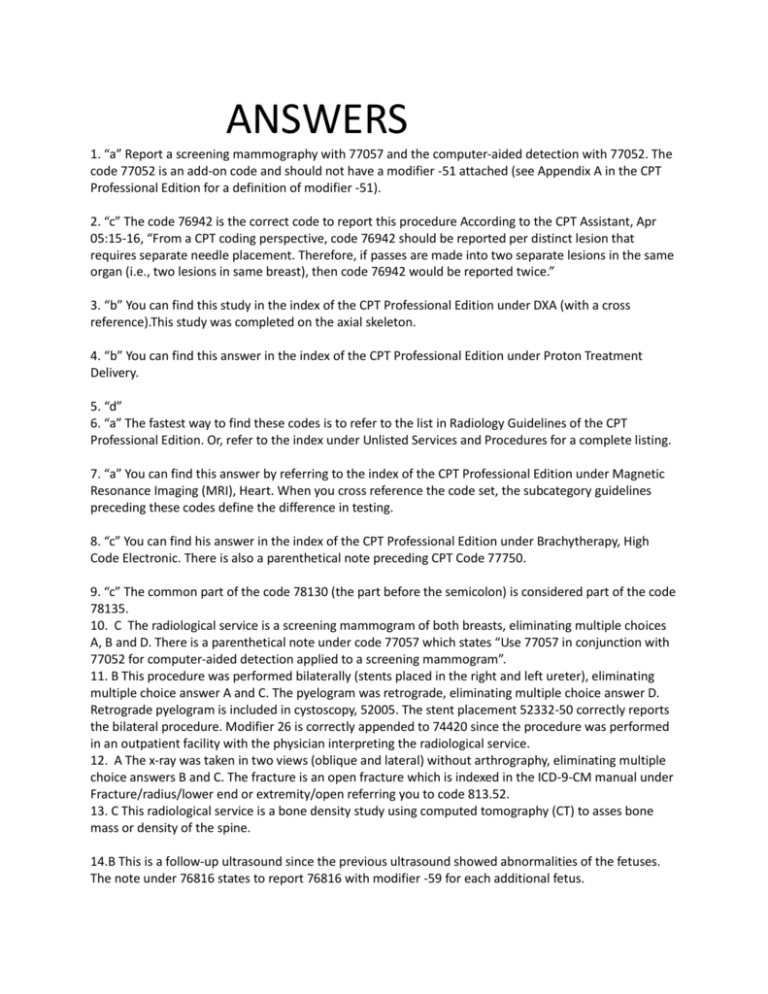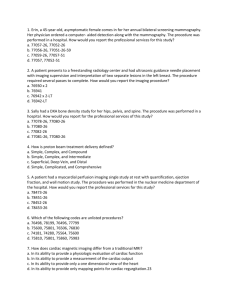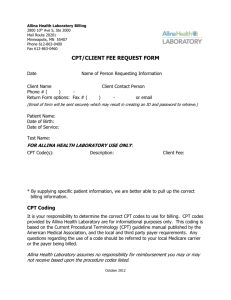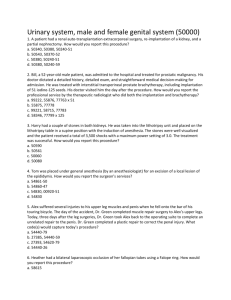Radiology Coding Answers: CPT & ICD-9-CM Key
advertisement

ANSWERS 1. “a” Report a screening mammography with 77057 and the computer-aided detection with 77052. The code 77052 is an add-on code and should not have a modifier -51 attached (see Appendix A in the CPT Professional Edition for a definition of modifier -51). 2. “c” The code 76942 is the correct code to report this procedure According to the CPT Assistant, Apr 05:15-16, “From a CPT coding perspective, code 76942 should be reported per distinct lesion that requires separate needle placement. Therefore, if passes are made into two separate lesions in the same organ (i.e., two lesions in same breast), then code 76942 would be reported twice.” 3. “b” You can find this study in the index of the CPT Professional Edition under DXA (with a cross reference).This study was completed on the axial skeleton. 4. “b” You can find this answer in the index of the CPT Professional Edition under Proton Treatment Delivery. 5. “d” 6. “a” The fastest way to find these codes is to refer to the list in Radiology Guidelines of the CPT Professional Edition. Or, refer to the index under Unlisted Services and Procedures for a complete listing. 7. “a” You can find this answer by referring to the index of the CPT Professional Edition under Magnetic Resonance Imaging (MRI), Heart. When you cross reference the code set, the subcategory guidelines preceding these codes define the difference in testing. 8. “c” You can find his answer in the index of the CPT Professional Edition under Brachytherapy, High Code Electronic. There is also a parenthetical note preceding CPT Code 77750. 9. “c” The common part of the code 78130 (the part before the semicolon) is considered part of the code 78135. 10. C The radiological service is a screening mammogram of both breasts, eliminating multiple choices A, B and D. There is a parenthetical note under code 77057 which states “Use 77057 in conjunction with 77052 for computer-aided detection applied to a screening mammogram”. 11. B This procedure was performed bilaterally (stents placed in the right and left ureter), eliminating multiple choice answer A and C. The pyelogram was retrograde, eliminating multiple choice answer D. Retrograde pyelogram is included in cystoscopy, 52005. The stent placement 52332-50 correctly reports the bilateral procedure. Modifier 26 is correctly appended to 74420 since the procedure was performed in an outpatient facility with the physician interpreting the radiological service. 12. A The x-ray was taken in two views (oblique and lateral) without arthrography, eliminating multiple choice answers B and C. The fracture is an open fracture which is indexed in the ICD-9-CM manual under Fracture/radius/lower end or extremity/open referring you to code 813.52. 13. C This radiological service is a bone density study using computed tomography (CT) to asses bone mass or density of the spine. 14.B This is a follow-up ultrasound since the previous ultrasound showed abnormalities of the fetuses. The note under 76816 states to report 76816 with modifier -59 for each additional fetus. 15. B Patient is having a broken tip of a catheter removed from the right ventricle, eliminating multiple choices A and D. There is a parenthetical note under code 37203 that states “For radiological supervision and interpretation use 75961“, eliminating multiple choice C. The fracture of the port-a-cath is a mechanical complication of a vascular device. 16. A Patient is having a peritoneocentesis performed, eliminating multiple choice answers B and D. The needle placement to withdraw the fluid was done under ultrasonic (imaging) guidance, eliminating multiple choice answer C. There is a parenthetical note under procedure code 49080 that states “If imaging guidance is performed, see 76942, 77012”. 17. B. The key words for this encounter are “dual energy”, which eliminates C and D. 77081 is the correct code since an example is given in parentheses what an “appendicular skeleton” is. The foot is in the same category as the wrist or heel which is considered peripheral bones. 18. D. When a selective catheter placement is performed, it includes the procedure to gain access. In this case the femoral access is to the aorta. From the aorta the physician selectively catheterizes the right renal artery which is considered a first order branch from the aorta reported with 36245. 36200 is included with 36245 and cannot be coded separately. Refer to Appendix L in the CPT® manual. The renal artery is considered a first order branch. Two imaging services are performed. The aortography (75625) is bundled with the renal angiography (75722). Only the renal angiography is reported. Modifier 26 is appended to report the professional component was performed by the physician for the radiology services. 19. A. The patient receives seven radiation treatments, which is reported with 77427. In the coding guidelines for this section it states, “ Code 77427 is also reported if there are three or four fractions beyond a multiple of five at the end of a course of treatment; one or two fractions beyond a multiple of five at the end of a course of treatment are not reported separately.” 20. C. Codes for MRI are determined by anatomical site and whether contrast is used. In this case, the MRI is of the lumbar spine. From the index, look up magnetic resonance imaging/spine/lumbar. You are referred to 72148-72158. Option A is an X-ray so it is not the correct answer. 72148 is without contrast, which is the correct code. According to ICD-9-CM Official Coding Guidelines, do not report signs and symptoms of a definitive diagnosis. In this case the patient complains of lower back pain and leg pain. He is diagnosed with lumbar spinal stenosis. The symptoms he presents with are symptoms associated with his diagnosis and should not be reported. From the index, look up stenosis/spinal/lumbar. You are referred to 724.02. Verify the code accuracy in the tabular section. 21. D. The patient presents for a ureteral catheter exchange via the ileal conduit. 50398 is not correct because it is for a nephrostomy tube which is in the kidney. 50393 is performed using a percutaneous approach, which is not used in this case. 50385 is performed using a transurethral approach, which is not correct. The exchange is performed via the ileal conduit, which is reported with 50688. Imaging is performed. There is a parenthetical note under 50688 that states that imaging is reported with 75984. 22. D. In the beginning of the obstetric ultrasound subsection in CPT®, there are descriptions of what is required for the OB ultrasound codes. In this case the ultrasound is limited because only two elements are examined the fetal heart rate and fetal position. This type of ultrasound is reported with 76815. In the code description it states “1 or more” which means the code is only reported once whether it is a single fetus or multiple fetuses. 23. C. Ultrasound codes are selected by anatomic site. The liver is an organ in the abdomen. Because the ultrasound is performed on one organ, it is reported as limited. Please note in the parentheses following code 76705 it states “one organ.” 76970 is not appropriate because this is an initial ultrasound and not a follow-up. 24. A. From the CPT® index, look CT scan/heart/evaluation/for coronary calcium. You are referred to 75571. Verify the code description. Codes 75572 and 75574 are performed with contrast so answer options B and C are not correct. 75557 is an MRI which is also incorrect. 25. B. The physician inserts the needle through the skin which indicates this is a percutaneous approach and not an open procedure. Answer options A and C can be eliminated. Fluoroscopic guidance was used, which is reported with 77002 for this type of procedure.




